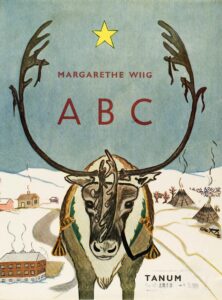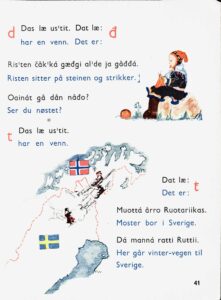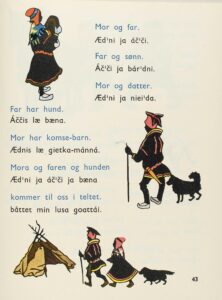The Sámi National Day (Northern Sámi: Sámi álbmotbeaivi) on February 6 is an ethnic national day for the indigenous Sámi people. It commemorates the date when the first Sámi congress was held in 1917 in Trondheim, Norway. This congress was the first time that Norwegian and Swedish Sámi came together across their national borders to work together to find common solutions.

In the European Digital Treasures project, we have included one document that relates to the Sámi people. It is a page from a textbook in Sámi entitled ABC (1951), and was made by Margarethe Wiig. When the book was published, it was the first textbook dedicated to Sámi children in their own language. The book is an example of how European countries have changed their policies towards minorities after World War II.
Margarethe Wiig (1903-2002) was the wife of a Norwegian priest and later bishop, Alf Wiig. From 1923 to 1934 she and her husband lived in Karasjok (Norway), where he was parish priest. Karasjok is located in the middle of the Finnmark plateau, in the midst of the Norwegian part of Sápmi (the Sámi area).
While Wiig lived in Karasjok, she became aware that there were no textbooks for education in Sámi. She was convinced that “an ABC book based on these children’s environment with partial use of their own language not only would be desirable, but also necessary.” Optimistic and committed, she set off, without any formal qualifications.
Wiig worked closely with Sámi children and experts in Sámi language and pedagogy when the book was made. She also drew inspiration from ABC books from other countries. The work with the textbook was an assignment from the Ministry of Church and Education, which was responsible for approving textbooks. She fought several battles with the ministry. They were for a long time negative to the idea of including texts in Sámi, but Margarethe Wiig was very determined that the book should have parallel texts in Sámi and Norwegian, so that the Sámi children could learn to read their own mother tongue.

In the final phase of the work on the book, the authoress was summoned to a secret meeting with the Ministry of Church and Education and the Ministry of Defence. In the meeting she was told that she had to change the map in the book (on the page shown here). Originally, she had placed a reindeer over both Norway, Sweden and Finland. It should illustrate that the Sámi covered areas in all three countries. That had to be changed so the reindeer didn´t touch Finnish land. Only many years later did she understand why. During the Cold War, Norway wanted only limited relations with Finland, due to the threat from the Soviet Union, to which Finland with its long common national border was very exposed.
The ABC book was a huge success. Sámi children had finally got their own textbook. It has been characterised as the most important in Sámi textbook history. And not only that, the book became popular in wide circles not least because of the colourful and beautiful illustrations. Several hotels in Finnmark had the book for sale. Good publicity for Norway, said the Ministry. Rumours of the successful textbook reached all the way to Korea. There it was used as a model for a textbook for Korean children. Margarethe Wiik later received a letter of thanks with greetings from 70,000 teachers and 3 million school children in Korea.

Norway’s Sámi policy had more or less focused on assimilation from the late 1800s to the 1960s. However, following World War II, there was a gradual shift in the attitude towards the Sámi people and their culture, coinciding with the rebirth of Sámi political organisations. The use of Norwegian and Sámi in schools is a good example of this shift. For several decades from the late 1880s, the school authorities, backed by politicians, pursued a strict policy of Norwegianisation. All school books were in Norwegian, and Sámi was only used as an auxiliary language to help pupils in the lower grades.
After World War II, government authorities included those who wished to abandon the Norwegian policy of assimilation and provide conditions that were more conducive to the promotion of the Sámi language and culture. Use of the written Sámi language has indeed increased since the 1970s. The Sámi Parliament was established in 1989 to deal with (among other things) issues relating to Sámi language, culture and society.
Text by Ole Gausdal, National Archives of Norway
Illustrations from the ABC book reproduced with the approval of
The Arctic University Museum of Norway
